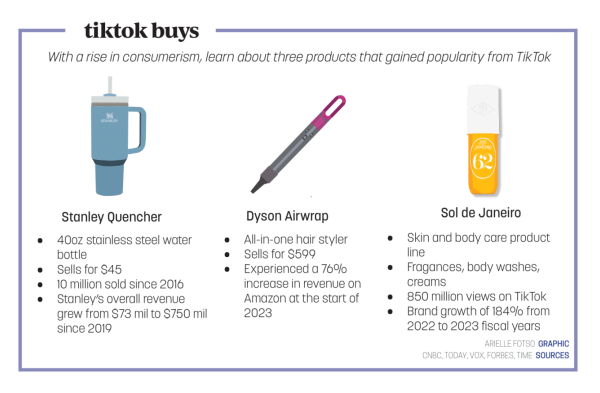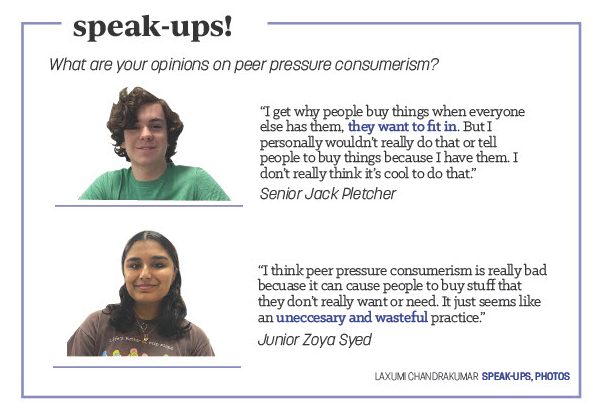The phenomenon of consumerism has been widespread for years, although, more teens are attempting to practice responsible financial habits. According to a 2024 survey by Piper Sandler, teen self-reported spending was down 6%, however, there was an increase in beauty and clothing splurges. However, overall spending may be down, sophomore Karen Sun said consumerism and trends continue to take over many conversations.
“I talk about shopping and trends maybe 80% of the time because there’s new trends all the time,” Sun said. “There’s something that could be funny or interest everyone because everyone has their own shopping ideal.”
Like Sun, economics teacher Michelle Foutz said despite the numbers she’s noticed a greater emphasis on consumerism as society pushes people to spend more and buy bigger.
“In our culture and society, we prioritize spending,” Foutz said. ” The term of conspicuous consumption, buying something for show, explains it. For example, buying a car for show instead of purely for transportation. Certain brands are associated with a higher status.”

Senior Vihaan Kottam said he recognized the vital role of trends in consumer culture.
“(Shopping) is usually trend-based,” Kottam said. “A lot of my friends love perfumes, so I used to buy colognes with them. A lot of my friends like cars, so I buy car parts with them. It’s just based on everybody’s interests and where they collide.”
However, Sun said spending habits don’t necessarily tie into trends.
“Whether we buy (a trending item) really depends on the specific thing because all our friends have a bunch of stuff already and we don’t need to rebuy every new thing that we see on the market,” Sun said. “It depends on if (the product) is worth it because we do try to save our money. There’s a lot (of spending) for clothing and makeup. Some popular brands right now are Summer Fridays, Brandy Melville and Stanley’s.”
Peer pressure and the influence of trends
With brands rising in popularity, junior Maggie Miller said the pressure of following trends has strained some relationships.
“My friendships have definitely been affected by the peer pressure of consumer culture,” Miller said. “Sometimes people change and you see yourself differently than them. Some people constantly try to update or change themselves, rather than just be who they are.”
In contrast, Sun said teens are able to stay individual, while exploring new trends and styles.
“I do think that the interest in shopping has helped me figure out what (other people’s) sense of style is and what they’re interested in and what they like and dislike,” Sun said. “I don’t think it affects (friendships) in a negative way because everyone has their own opinions and they can’t be quick to judge. (Consumerism) can help (me) to know about more people’s styles and helped me discover more interests. Because they’re so many different trends, instead of copying every other person’s (style), I figure out what I like and discover new things.”
Echoing Sun’s sentiments, Miller said teenagers need to prioritize staying true to themselves when faced with consumer culture.

(Keira Kress)
“Each person needs to make a choice for themselves,” Miller said. “People have gotten conditioned to try to be perfect in society’s eyes rather than just enjoy themselves. It’s taken away from who people actually are. Ask yourself if something is really what you want to do. At what point will people realize (the trends) are not them? Corporations aren’t going to stop because they want to maximize money, so this change has to be on the consumer level.”
While change must happen with individuals, Sun said this may be difficult with the pressure to follow school-wide trends.
“(Trends) influence our opinion; a bunch of people in our school wear the same thing,” Sun said. “It influences the ‘school style’ and doesn’t allow people to express their own sense of style. Maybe your friends like (to dress) this way and then you (are) like, ‘Oh, yeah, I like that too.’ I see, especially in our school, everyone likes to wear similar (clothing) and different schools, on social media, have a completely different style than ours.”
Kottam said while he acknowledged negative aspects of school trends, there were also positive sides.
“If people feel like they need (to follow the trends) to be worth your while then that is (the) negative end, but there’s also positive aspects to trends,” Kottam said. “I mean, it brings people together. It is a colliding factor.”
Social media plays a role
The presence of technology has increased, and alongside technology is social media. Recently, several social media platforms have developed markets of their own, such as Facebook Marketplace, TikTok Shop and Instagram Shopping. Foutz said the changes in technology also had a significant impact on consumerism.
“When I was a teenager, there were no cell phones, and the only advertisements were from TV, so there was a lot less exposure,” Foutz said. “Today, teens are getting (ads) from every direction all the time. It’s everywhere around us, there’s more pressure.”
Miller said the increased accessibility of social media and social media marketing impacted the younger generations negatively.
“I know young kids with so many skincare and makeup products who follow every trend,” Miller said. “It’s sad because we don’t need those things.”
Like Miller, Sun said the younger generation was affected by unhealthy spending habits on social media.
“I think it’s affecting the younger generations by spending (on) things that they don’t even need,” Sun said. “I (would) really say the ‘Sephora kids’ who buy makeup (are influenced) because they’re 10 years old and they don’t even need makeup. I think it affects them because then a bunch of the parents, they buy them all these things.”
Spending habits

According to a 2023 survey by Piper Sandler, 60 to 61% of the money spent by teens was contributed by parents. Agreeing with the trends, Kottam said teenagers today don’t understand money management and lack responsible spending habits.
“(Teenage spending) promotes irresponsibility because like most people that are spending the money aren’t spending their own money; they’re spending their parents’ money,” Kottam said. “They don’t understand the work (until) later and it’s hard to determine when you’ll understand, like, how expensive things really are and like, how useful things really are.”
In disagreement, Miller said many teenagers such as herself have jobs that help them understand the value of money.
“It’s important to work and have your own money to spend,” Miller said. “I’ve had a job for two years and I’ve figured out how I want to spend my money. Sometimes I want to spend a lot, but I remember I’m also working for the future.”
Like Miller, Sun said getting a job helped her learn more about money management. She developed her own methods after getting a job.
“Recently I had (gotten) my own source of money and I really want to take care of my own money and save up instead of just spending it all at once. I learned this trick where if I want to buy something, I always wait a week and still think about it to see if I actually really need (the item) or not because sometimes I do get urges to want to buy something,” Sun said. “But I just wait a week and like most of the time I change my mind and then I don’t end up buying it. I try to save my money because I have to use my own money for a lot of things. So then it really helps me learn to not spend it all at once.”
Despite the ongoing trends, Foutz emphasized the importance of learning money management as a teenager.
“Consumerism and excessive spending is a problem down the road,” Foutz said. “It’s important to teach students and kids about the value of saving. It’s important to emphasize thoughtful spending, not frivolous spending.”



